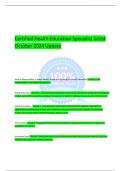Certified Health Education Specialist latest
October 2024 Update
Area of Responsibility I: Assess Needs, Assets and Capacity for Health Education - Answer--The
Responsibility of the Needs Assessment
Health Education - Answer--- ''Any planned combination of learning experiences designed to predispose,
enable, and reinforce voluntary behavior conducive to health in individuals, groups, and communities''
Health Promotion - Answer--- ''Any planned combination of educational, political, regulatory, or
organizational supports for actions and conditions of living conducive to the health of individuals,
groups, and communities'' (Green & Kreuter, 2005, p. G-4).
Primary Data - Answer--Data gathered by the Health Education Specialist directly from or about the
population of interest.
Secondary Data - Answer--Data gathered by others that may or may not be directly collected from the
individual or population of being assessed.
,Health Behavior - Answer--Behavior that impacts a person's health.
Needs Assessment - Answer--A process by which Health Education Specialist gather information
regarding health needs and desires of a data population. Plan for the process , assess resources, locate
existing data, collect data , using research methods to guide data collection.
Steps of the Need Assessment - Answer--1. Determine the scope
2. Gather the Data
3. Analyze the data
4. Identify risk factors
5. Prioritize the need
6. Validate the need
Rapid Model - Answer--The framework for when money is limited.
Asset model - Answer--Strengths of community organization or population; using existing resources to
improve health.
Public Health Model - Answer--Quantify Epidemiological Data
Epidemiological Model - Answer--Epidemiological Data
Social Model - Answer--The influence of Social or political Issues on health.
Stakeholders - Answer--These people may be involved in program operations such as program manager,
program staff, partners, funding agencies, coalition members of those served or affected by the
program / project including patients , clients , advocacy groups and community members.
, Epidemiology - Answer--The study of the distribution and determinants of health related states and the
application of this study to control health problems.
Individual factors - Answer--Educational , social and cultural characteristics of the individuals. Person's
knowledge , attitudes, beliefs and perceptions, related to health culture, religious and spiritual beliefs
and skill set.
Informed consent - Answer--Disclosure of information to prospective subjects about the research
(program) their comprehension of the information and their voluntary agreement , free of coercion and
undue influence to research.
Predisposing Factors - Answer--Any characteristic of a person or population that motivates a behavior
prior to occurrence of behavior [ Individual knowledge and affective traits].
Enabling Factors - Answer--Any characteristics of the environment that facilitates action and skill of
resource required to attain a specific behavior [ Factors that make possible a change in behavior]
Reinforcing Factors - Answer--Any reward or punishment following or anticipated as a consequence of a
behavior serving to strengthen the motivation for the behavior after it occurs.
Primary Data Sources - Answer--Written Questionnaires, Nominal Group Process, Delphi Technique ,
Community Forum , Walkthrough tour, Observation, Photovoice, Windshield tour, Interviews
Secondary Data Sources - Answer--Literature, Peer- reviewed journals, CDC, US Department of Health
and Human Services, Morbidity and Mortality Weekly Report Health Resource Service Administration,
National Center for Health Statistics BRFSS ( Behavioral Risk Factor Surveillance System)




